Juvenile gray whale strands in Bremerton
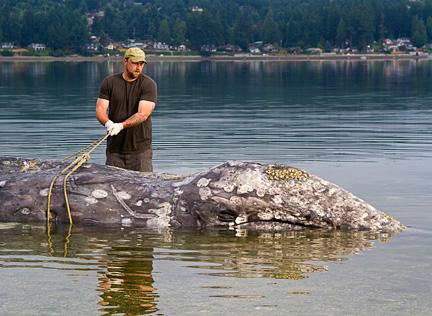
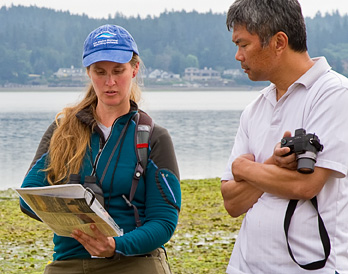
Necropsies of marine mammals are vital to understanding the health of overall populations - as well as, of course, the cause of death for an individual animal. The work performed by the biologists, interns and volunteers is not only a challenge of mental and scientific sleuthing, but also an extremely physical endeavor. View a gallery of the whale’s necropsy. WARNING: While we have edited images carefully to be representative of the necropsy, but not overly graphic, it is not suitable for viewing by small children.
Lend a hand for beach cleanup and save marine life


NOAA has produced several children’s activity booklets about marine debris that are available here for download: Protect the Ocean and Understanding Marine Debris. Both contain puzzles and illustrations that help kids understand the importance of keeping the beaches and marine waters free of trash - so that sea life will be here for many generations to come!
Thanks to the Americorps (Washington Reading Corps of South King County) volunteers who will be participating in the beach cleanup as well as members of ACC and Seal Sitters. This event is open to the public and all those interested in making a difference for the environment. If you, your group, or class would like to lend a hand, meet us at the Statue of Liberty across from Starbucks (Alki Ave SW near 61st) at 9am. If you have questions, please contact Larry Carpenter @ 206-938-0887. Special thanks to Carol Baker and Colleen Hackett of Seattle Parks for providing cleanup tools. Tully’s, Starbucks and Pioneer Coffee are all generously donating coffee to keep our volunteers warm and energized throughout the morning. We hope to see you there!
Gray whale strands on Tulalip Reservation
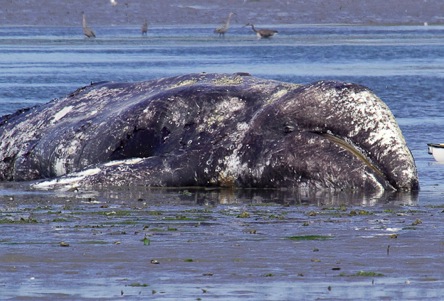
The Everett gray whale stranded yesterday in Tulalip Bay on the Tulalip Reservation. Members of Seal Sitters, Sno-King Marine Mammal Stranding Network and WDFW responded to the scene. The mud flats of the bay restricted access to the whale which lay exposed to the extreme sun and heat. As the tide came in, however, the Tulalip Bay Fire Department zodiac managed to get a pump close enough to keep the whale wet and cool. A borrowed canoe allowed a stranding team member to get sheets to the scene so the whale could be covered and more protected. The tide finally covered the whale about 2pm. The Tulalip tribes honored the whale and prayed for him to get well. The repeated stranding behavior of this adult whale is indicative that he is most likely dying. The gray was spotted by NOAA on Saturday at 4:30 at Spee-Bi-Dah heading north into Port Susan. See related gallery of photos.
UPDATE:
7/13/10 Transient orcas were seen attacking the gray whale yesterday afternoon (Monday). Related story and video.
7/12/10 The gray was spotted this morning (Monday) at 6:30 am heading east toward Camano Island.
Gray whale strands in Everett
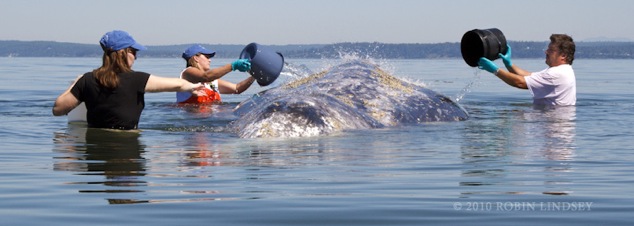
Yesterday, however, the whale was marooned on the beach at low tide. Concerned neighbors in shorts and swimsuits assisted in keeping the exposed whale wet and cool. However, as the water rose and the whale became more active it became too dangerous for them to continue to help. Members of the NW Stranding Network (above photo from left, Jessie Huggins of Cascadia Research, Kristin Wilkinson of NOAA, and Brian Chittick of Snohomish-King County Stranding Network) labored for hours pouring buckets of water over the whale - until finally the incoming tide created a water level deep enough that he could swim free. They then boarded a boat with a team from WDFW Marine Mammal Investigations and monitored the whale until 2pm when he finally left the shallower waters and headed out into the strait.
Early this morning the whale stranded again and the Stranding Network responded. Approximately 2:30 this afternoon he was in 7-10 feet of water as the tide came in. NOAA is not optimistic about the whale’s survival based on his behavior and weakened condition.
Gray whale necropsy reveals trash inside stomach

The public should give many thanks to the necropsy team for performing this incredibly important and physically strenuous work. Due to their dedication and efforts, we are now aware of the role that pollution may have played in the death of this whale - as it indeed impacts all our marine life. Plastics that end up in our waters never go away - they eventually end up as micro particles which absorb contaminants and enter the marine food chain, causing deformities and disease. It is well known that our local seals and orcas are laced with pcbs and other toxic chemicals. Depletion of food sources caused by commercial overfishing and pollution can be reversed by getting involved. You CAN make a difference - pick up trash on the beach, don’t purchase seafood on the seafood watch list and ask your grocer not to sell it, help clean up the Sound.
As an observer, our volunteer was stunned at the amount of trash that was removed from the whale - and overwhelmed with sadness that human impact had, in any way, contributed to this whale’s demise. Please learn more about our polluted waters and the Great Pacific Garbage Patch, an oceanic swirling mass of plastic twice the size of Texas, on Seal Sitters’ website. Educate people about the dangers of pollution and its tragic impact on our wildlife now and for generations to come. Make a commitment that this magnificent whale’s life was not given in vain.
See news video here.
Read Lynda Mape’s excellent article in the Seattle Times.
Gray whale strands in West Seattle
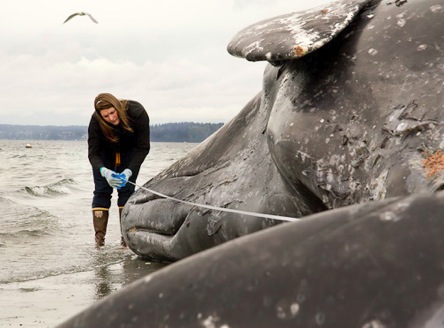
The whale is being towed to an undisclosed location where a necropsy (tentatively scheduled for Sunday) will be led by Cascadia Research and WDFW biologists. The body will be left to decompose over time and nourish the ecosystem. A local college will then recover the skeletal remains for educational purposes. View a photo gallery.
UPDATE: 4/20 NECROPSY RESULTS REVEALED
For the disturbing necropsy results on this gray whale, please click here.
Links of interest:
Seal Sitter founder and renowned nature writer Brenda Peterson co-authored (with native American Linda Hogan) the book, Sightings: The Gray Whale’s Mysterious Journey.
Seal Sitter scientific advisor, Dr. Toni Frohoff, is featured in a New York Times Magazine article about the gray whale birthing lagoons in Baja, Mexico.
SAD UPDATE: According to Cascadia Research, the gray whale seen feeding in West Seattle waters (not the whale discussed in the above post) on March 27th has been photographically matched to a 40 foot adult whale that died on April 11th near Fidalgo Island. Read the report here.
Related news:
Gray whales wash up in area waters (Vancouver Sun)







